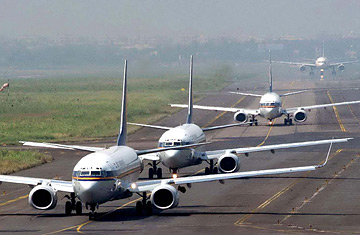
Airliners wait to take off at Bombay Airport
These are heady times for India's fast-growing airline industry, which has been charting roughly 25% growth for the last three years. Never before have so many Indians found it so convenient and so affordable to fly for work or leisure, thanks to competition between a bevy of carriers like Air Deccan, SpiceJet, Kingfisher, IndiGo and Go Air. Their rock-bottom airfares have helped make more of India accessible to Indians, turning backwaters into boom towns. Last year, Indian airports handled 90.44 million passengers, compared with 67.95 million in the previous year.
But this explosive growth has met the same problem that other suddenly successful industries have encountered in India: There has been no accompanying growth in infrastructure, leaving airports struggling to cope with long queues of harried passengers and severely compromising air safety. A series of so-called near-misses in New Delhi over the last two weeks has focused attention on a host of problems ranging from shortage of air traffic controllers and pilots to outdated technology and inadequately maintained equipment at the 125 airports around the country. Experts say it is a wonder disaster has not yet struck.
"India needs 4,000 air traffic controllers, but has only 1,500," says D.S. Raghavan, president of the Delhi-based Air Traffic Controllers' Guild. He says Indian traffic controllers work without weekly breaks to make up for the shortfall, which is against international norms and poses severe safety risks. "Given how stressful the job is, traffic controllers are allowed to work no more than eight hours a day, and 110 hours a month. But we work 10-hour shifts round the year!"
Pilots are also in shortage, too — it is estimated that the industry needs 400 pilots a year but produces only about 100. While new training schools are being set up, nearly a quarter of India's 2,300 pilots are foreigners. Due to the shortage, there have been several reported cases of pilots with invalid licenses or who should be in retirement but continue to serve. An air passengers' organization has also been campaigning against what it calls lax health checks for expatriate pilots who are given temporary, six-month licenses.
This December has been particularly bad for Delhi's domestic and international airports. An airport radar broke down on December 8 and some 40 flights were delayed. Thousands of passengers were left in the lurch. The onset of winter fog in December has also delayed scores of flights, despite the DGCA's much-publicized installation of the advanced CAT-III system to aid with low-visibility landings. It turns out that many of the new Indian domestic airlines, including some that fly internationally, do not have enough CAT-III trained pilots, not deeming it necessary because foggy conditions occur only a few days each year.
Industry insiders have been pointing out that with more than 35% of airspace under the military's control, not enough is let to fill the growing demands of civil aviation. At the same time, a shortage of runways and inefficient operating procedures often result in flights having to hover over airports for hours before they are cleared to land.
A series of near-collisions also led the DGCA to decree that simultaneous operations on the two runways — whose flight paths merge instead of lying parallel — be discontinued. Those simultaneous runway operation had been implemented in April 2006 to increase flight departures and arrivals from 25 to 42 per hour. That was, however, a violation of international safety norms because Delhi's runways do not lie parallel. A new parallel runway will not be operational until the middle of next year, and traffic movement will slow down considerably until then.
There are other problems. During a surprise check by the Directorate General of Civil Aviation (DGCA) earlier this month — during Air Safety Week — a pilot was found drunk on duty. The check also revealed that airline crews, including pilots, were often giving dispensing with pre-flight briefings, a serious lapse since they are how pilots get updates on weather and navigation.
Inadequate attention to safety concerns is also reported from the ground — in October, a young ground staffer was run over by an inter-terminal bus inside Delhi's international airport. Earlier this month, a state-level minister was hurt when the driver of the boarding bus braked suddenly to avoid a collision at Delhi's domestic airport. The bus driver had been talking on a cell phone.
Many observers believe privatizing the airports may solve many problems. But it is always a touchy subject in India. The Delhi and Mumbai airports were privatized last year in the face of strong protests from employees' unions and left-wing parties allied with the ruling Congress party. Like many other things in India, politics rears its head in running the airline industry. "Important policy decisions... are pending before the government," says Joseph Thachil, former editor of aviation magazine Skyflier, "but with elections due in 14 months, they will likely remain pending."
